*NURSING > QUESTIONS & ANSWERS > NURS C475 Care of the older Adult study guide (complete solution guide) latest Fall 2020 (All)
NURS C475 Care of the older Adult study guide (complete solution guide) latest Fall 2020
Document Content and Description Below
Care of the older Adult: #1 Competency 742.1.1: Compassionate and Respectful Care of Older Adults 1. How do you define Baby Boomers? 2. What are the five racial groups listed in text? 3. How... would you perform discharge teaching to an Hispanic patient? 4. How would you perform discharge teaching to a European American patient? 5. How would you perform discharge teaching to an Asian American patient? 6. How would you perform discharge teaching to an African American patient? 7. How would you perform discharge teaching to a Native American patient 8. What is the concept of individualized care? 9. What are some visual changes related to aging? 10. What are some communication accommodations that can be made for visual deficits? 11. What are some hearing changes related to aging? 12. What is presbycusis? 13. What are some communication accommodations that can be made for hearing deficits? 14. What are some speech/language changes associated with aging? 15. What are some communication accommodations that can be made for speech/language deficits? 16. What are some somatosensory changes associated with aging? 17. What are some communication accommodations that can be made for somatosensory deficits? 18. What is an AAC? 19. What are some communication tips for someone with dysarthria? 20. Describe a BTE: 21. Describe an OTE 22. Describe an ITE 23. Describe an ITC 24. Describe a CIC 25. What patients could benefit from an AAC? 26. What are Satir's five principles of contact and communication? #2 Competency 742.1.2: Health Promotion/Maintenance and Living Environments of Older Adults 1. What are the five A's to tobacco cessation? 2. What are the Five R's to tobacco cessation? 3. What is the criterion for the pneumococcal vaccine? 4. What 5 areas do Healthy People 2010 and the USPSTF suggest that nurses focus on to promote health & prevent disability in the older adult? 5. Describe the difference between ADLs and IADLs (instrumental activities of daily living) 6. Review the USPSTF Screening Recommendations for Older Adults, Table 12-1 on page 376 in text. 7. Review the I HATE FALLING risk assessment tool, Box 12-4 on page 361. What can the nurse recommend to reduce risk of falling? #3 Competency 742.1.3: Health Needs of Older Adults 1. What are the 5 most common geriatric syndromes? 2. What aspects of pharmacokinetics are affected by age-related changes? 3. How is absorption of medications affected by age related changes? What is the significance? 4. How is distribution of medications affected by age related changes? What is the significance? 5. What do you have to take into account when evaluating creatinine levels in the elder adult? 6. How is metabolism of medications affected by age related changes? What is the significance? 7. How is excretion of medications affected by age related changes? What is the significance? 8. How is the pharmacodynamics of medications affected by age related changes? What is the significance? 9. What are some functional changes and mobility issues that may threaten independence in the older adult? 10. What are some factors that may contribute to alterations in nutrition in older adults? 11. What are some examples of alterations in metabolism in older adults? 12. What are some factors that may contribute to alterations in elimination in older adults? 13. What are the signs and symptoms of pressure ulcers? 14. What are the risks for pressure sores? 17. Explain the difference between intrinsic and extrinsic risk factors for falls. 18. What is a MAP? 19. What are the Five Rights of Medication Administration? 20. Why are older adults more apt to polypharmacy? 21. What are some ways to avoid polypharmacy? 22. What common classes of drugs cause ADRs? #4 Competency 742.1.4: Promoting Independence and Autonomy While Reducing Risk Factors in Older Adults 1. What is autonomy? 2. What is self-determination? 3. What is frailty? 4. What are the characteristics of frailty? 5. What is the Kohlman Evaluation of Living Skills (KELS)? 8. What are the factors that influence the quality of life of an older adult? 9. What is the one of the most common role changes faced by the aging person? List all. 10. What is role reversal for the older adult? • 11. List and the care options for the older adult (when independent living is no longer possible) 13. Describe the care option of independent living with help 15. Describe the care option of adult daycare at a facility 16. Describe the care option of adult daycare at a home 17. Describe the care option of family 18. Describe the care option of adult daycare at Senior living complexes/continuing care/supported care retirement communities 19. Describe the care option of assisted living 20. Describe the care option of paid in-home caregivers 21. Describe the care option of extended care facilities What is the Borg Category Rating Scale? 22. What are the common signs of abuse in an older adult and who is mostly to be the abuser? 23. Who is mostly to be the abuser? 24. List common tools used to assess abuse in the older adult 25. Describe the Framingham Heart Study. What did it look at and what were the findings? 26. What are the risk factors for stroke? 27. How does a-fib affect stroke risk? 28. Describe thyroid dysfunction risks in the elder adult 29. Describe osteoporosis risks in the elder adult 30. Describe visual dysfunction risks in the elder adult 31. Describe prostate cancer risks in the elder man • 34. Describe breast cancer risks in the elder adult • Breast cancer is the most common cancer among U.S. women, and the prevalence of the disease increases with age. According to the CDC (2008), 3-4% of women who are 60 years old today will get breast cancer by the age of 70. • Other risk factors for the disease include family history of breast cancer, atypical hyperplasia in breast tissue, and birth of a first child when a woman is over 30 years of age. • There is fair evidence to support benefit from breast cancer screening for older women by mammogram every 1-2 years. 35. Describe colorectal cancer risks in the elder adult 37. What d/c instructions might a nurse give to a patient regarding pharmacies and medication safety? #5 Competency 742.1.5: Promoting Health and Independence in Older Adults 1. What is the definition of a fall? 2. What can happen to an older adult after a fall? 3. What is the biggest risks for falls? 4. What are intrinsic risk factors for falls? 5. What are extrinsic risk factors for falls? 6. Among older adults living in the community, when and where do most falls occur? 7. What can you do to prevent falls? 8. What are some ways you can modify the inpatient environment to prevent falls? 9. What medications should you pay particular attention to when assessing fall risk? 10. What are some ways you can modify the home environment to prevent falls? 11. What are the types of restraints used? 12. What is a physical restraint? 13. What is a chemical restraint? 14. What are the effects of restraint use on the elderly? 15. What are alternatives techniques (instead of restraints) to deal with wandering, combative or confused patients? 16. What are the two most widely publicized components of health promotion? 17. What are some of the preventive care services covered under Medicare? 18. Describe a health contract 19. Explain Bailey's Bull's eyes 20. Describe Healthy People 2000 21. Describe Healthy People 2010 22. Define health promotion vs. health screening 23. What are the three types of prevention? 24. What is primary prevention? 25. What is secondary prevention? 26. What is tertiary prevention? 27. What is the chronic disease self-management program (CDSMP)? 28. What are the barriers to physical activity for the older adult? 29. What is the major risks of a sedentary life style? 30. What are the four leading causes of death in the US? 31. Why might older adults be at risk for poor nutrition? 32. What is a healthy BMI? When might we be concerned? 33. What lab values might show malnutrition in the older adult? 34. Are older adults at risk for alcohol abuse? If they are, what can be done to re-educate them and prevent harm? 35. What are the five A's for a patient wishing to quit an unhealthy habit? 36. What are the five R's for a patient not willing to quit an unhealthy habit? #6 Competency 742.1.6: Technology-Assisted Care of Older Adults 1. What is the goal of assistive technology? 2. What is assistive technology? 3. Which type of patients are more likely to use assistive devices? 4. What are some potential barriers to adult learning? 5. What are the guidelines for Introducing Technology and Teaching the Elderly about its use? 6. What are some ways in which the Nursebot robot may assist with the elderly? 7. What may we see with sensor-based monitoring systems in the future? #7 Competency 742.1.7: Health Care Systems and Reform 1. What are the intentions of the Affordable Care Act? 2. What is the Independence at Home Demonstration? 3. What provisions of the ACA have already taken effect? 4. 2012 mandate The US Supreme Court upheld provisions to expand Medicaid and Medicare coverage 5. The intent of PPACA in terms of Medicare is to reduce overall cost while maintaining coverage to those entitled to Medicare. 6. A national Medicare pilot program will be developed to provide Medicare recipients with more options for long-term care, including primary care services in their homes rather than institutional care. 7. Increase services that will impact the older population include providing wellness and prevention programs at no cost to the individual and prescription drug discounts. 8. What does Medicare Part A cover? 9. What does Medicare Part B cover? 10. What does Medicare Part C cover? 11. What does Medicare Part D cover? 12. What does Medicaid cover? 13. Who is eligible for Medicare? 14. How is Medicare Part B funded? 15. Who is eligible for Medicaid? 16. Are nursing homes covered by Medicare? 17. What is Triple Aim of healthcare reform? 18. Can a person over 65 qualify for Medicare if they have not paid into Medicare taxes for a total 10 years? 19. What is a healthcare premium? 20. What is a healthcare deductible? #8 Competency: Care Transitions 1. Describe A Shift to Different Living Facilities as a Transition Model 2. What are Continuing care retirement communities (CCRCs)? 3. What is a Green House? 4. What is a professional geriatric care manager (PGCM) ? 5. What services may a PGCM perform? 6. What is the difference between multidisciplinary and interdisciplinary teams? 7. Who is usually on an interdisciplinary team? 8. What is the nurse's role in the multidisciplinary team? #9 Competency 742.1.9: Palliative and End-of-life Care 1. What is curative care? 2. What is palliative care? 3. What is hospice care? 4. What is an advance directive? 5. What if there is no advance directive or living will? 6. What is a living will? 7. What is the nurse's role in advance directives/living wills? 8. What are the signs of impending death? 9. What is nociceptive pain? 10. What are the symptoms of somatic nociceptive pain? 11. What are the treatments for somatic nociceptive pain? 12. What are the symptoms of visceral nociceptive pain? 13. What are the treatments for visceral nociceptive pain? 14. What is neuropathic pain? 15. What are the treatments of neuropathic pain? 16. Should an older adult in pain and receiving palliative care be concerned with addiction? 17. What is drug dependence? • Physical response to use of opioids, characterized by withdrawal symptoms when the opioid is stopped. 18. What is drug tolerance? 19. What are the five wishes in regard to end of life care? [Show More]
Last updated: 2 years ago
Preview 1 out of 47 pages

Buy this document to get the full access instantly
Instant Download Access after purchase
Buy NowInstant download
We Accept:

Reviews( 0 )
$20.00
Can't find what you want? Try our AI powered Search
Document information
Connected school, study & course
About the document
Uploaded On
Oct 22, 2020
Number of pages
47
Written in
Additional information
This document has been written for:
Uploaded
Oct 22, 2020
Downloads
0
Views
95

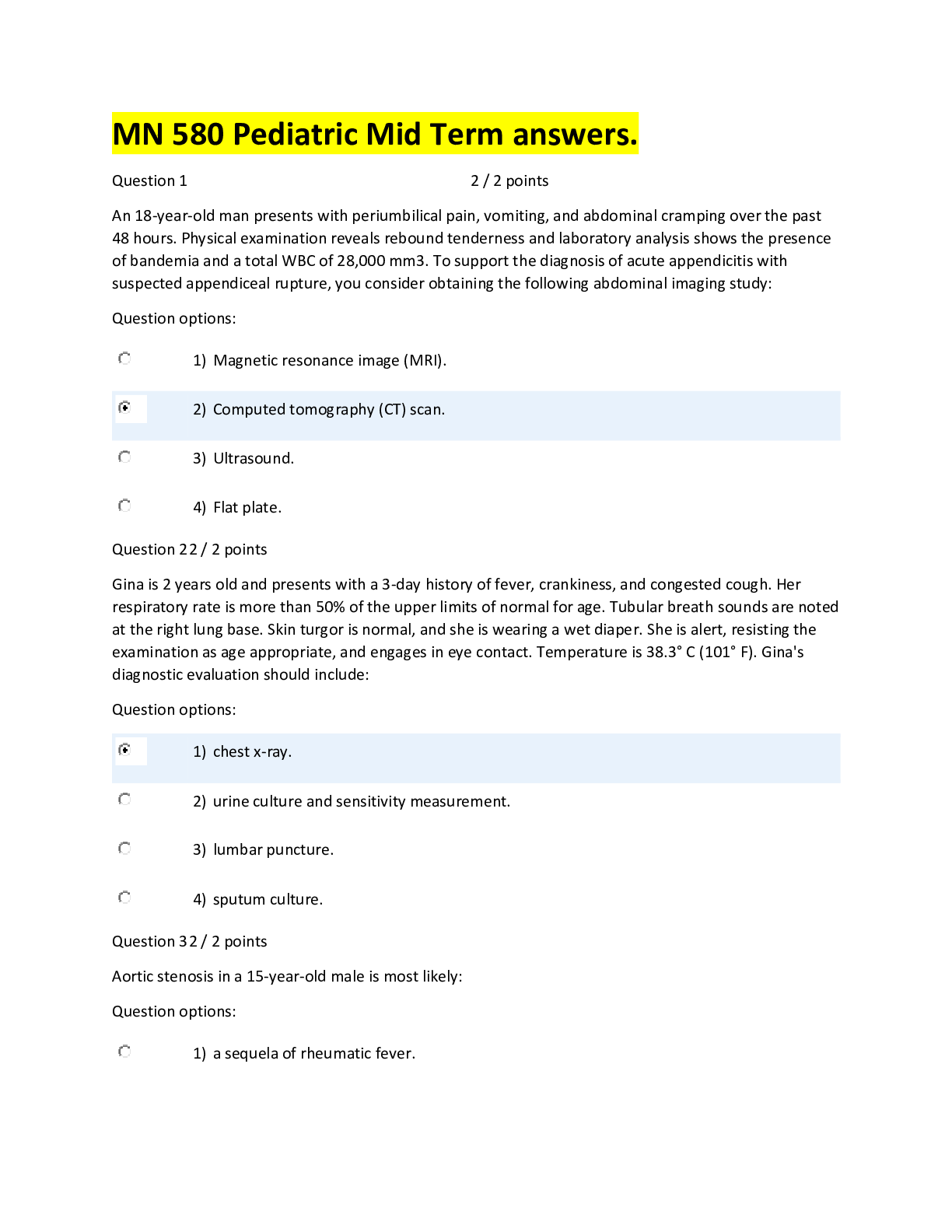
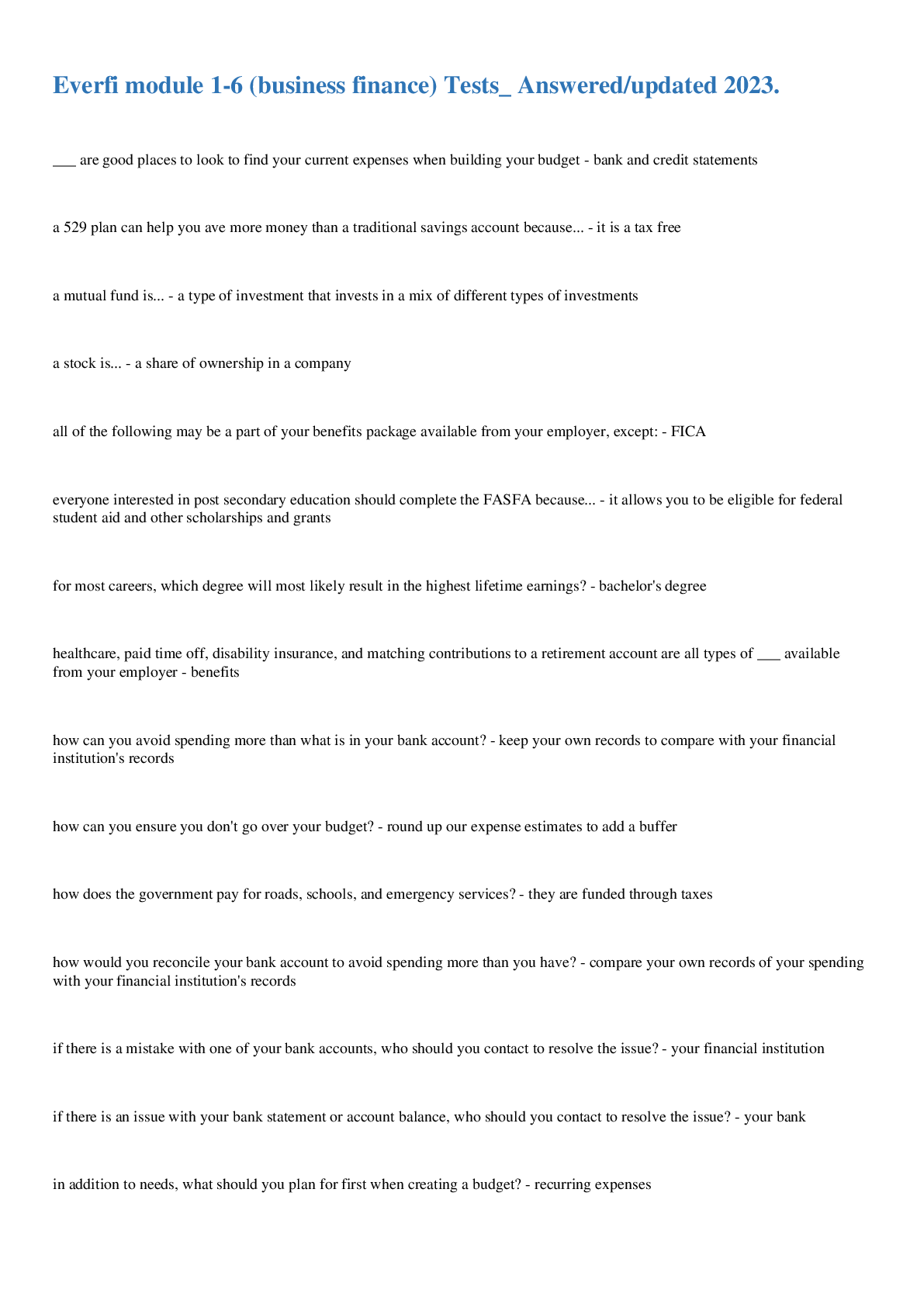

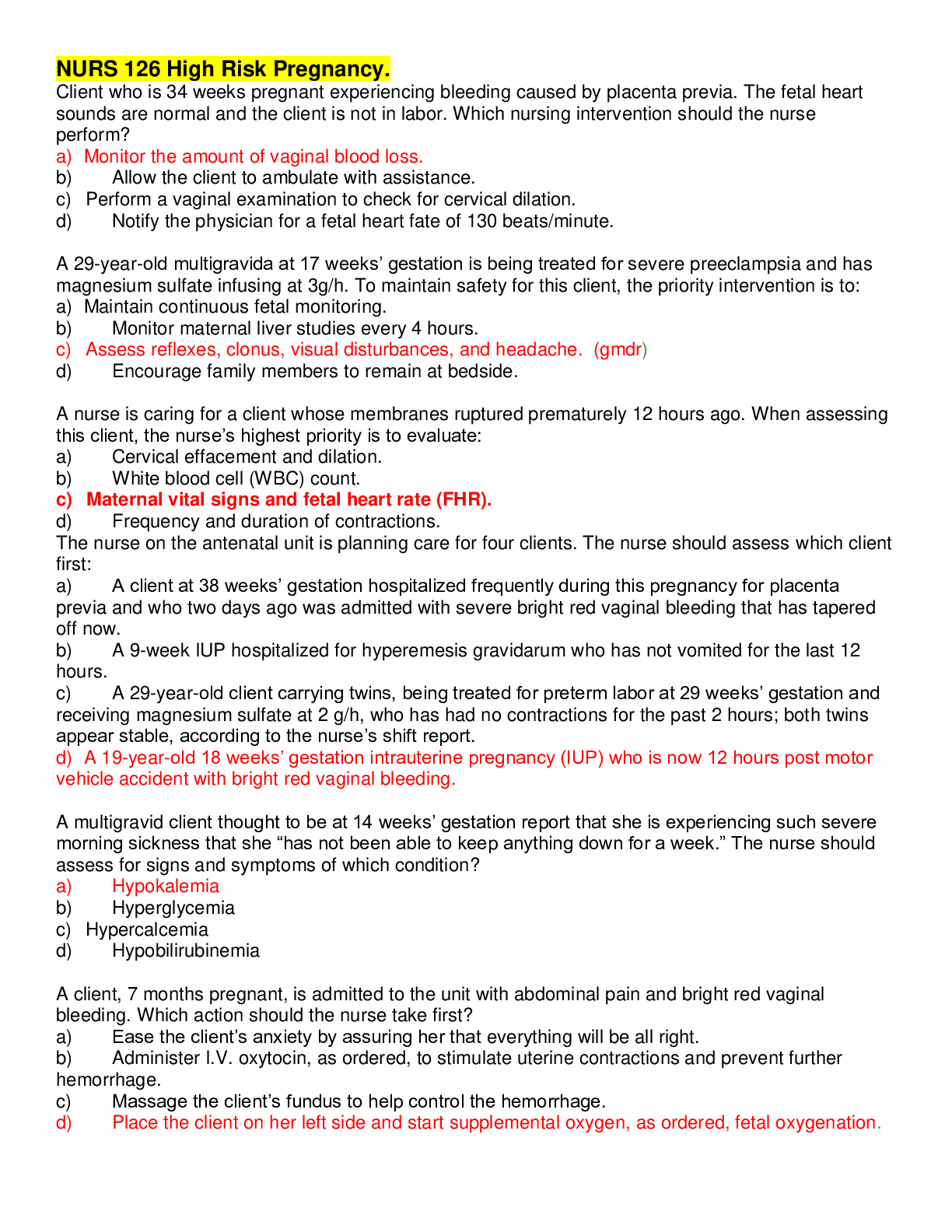


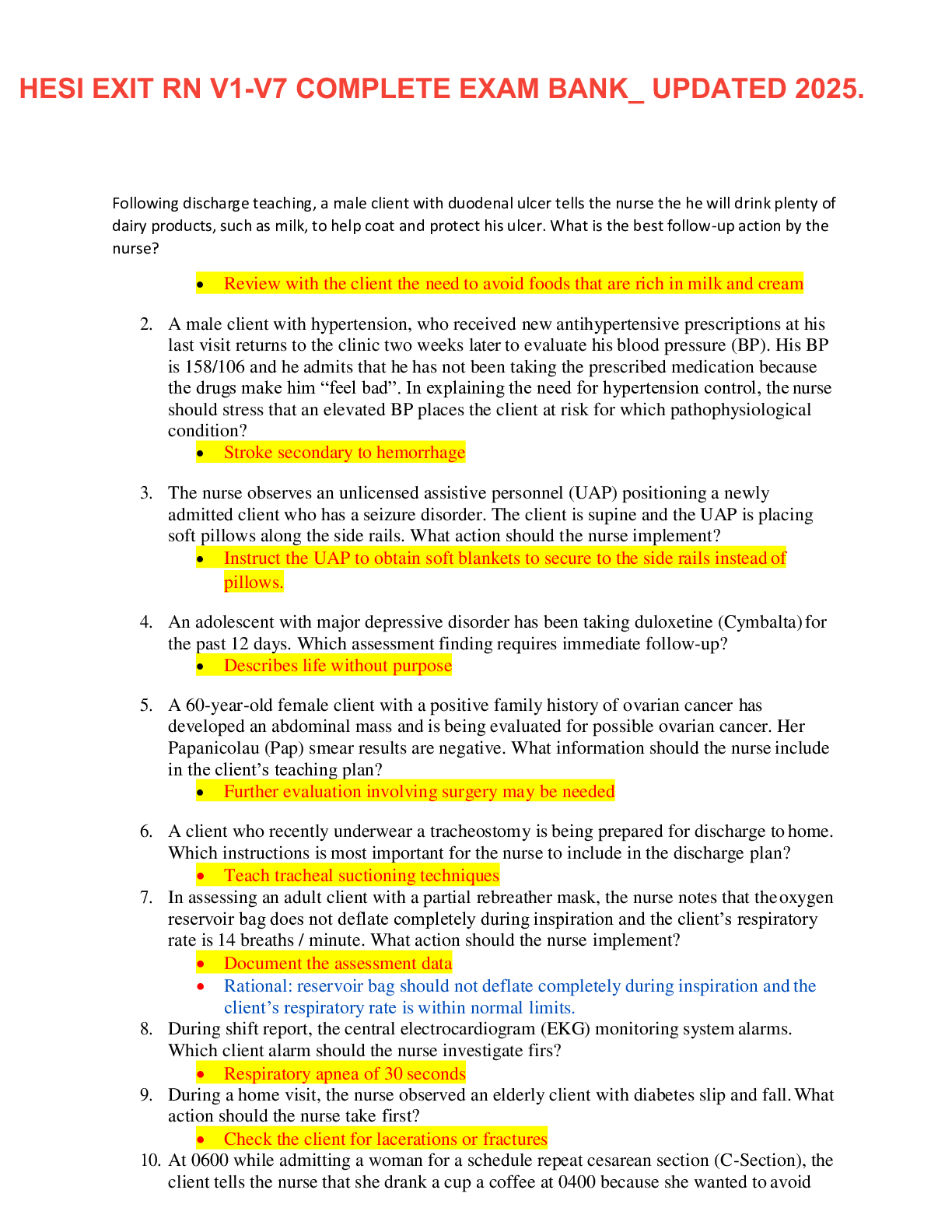
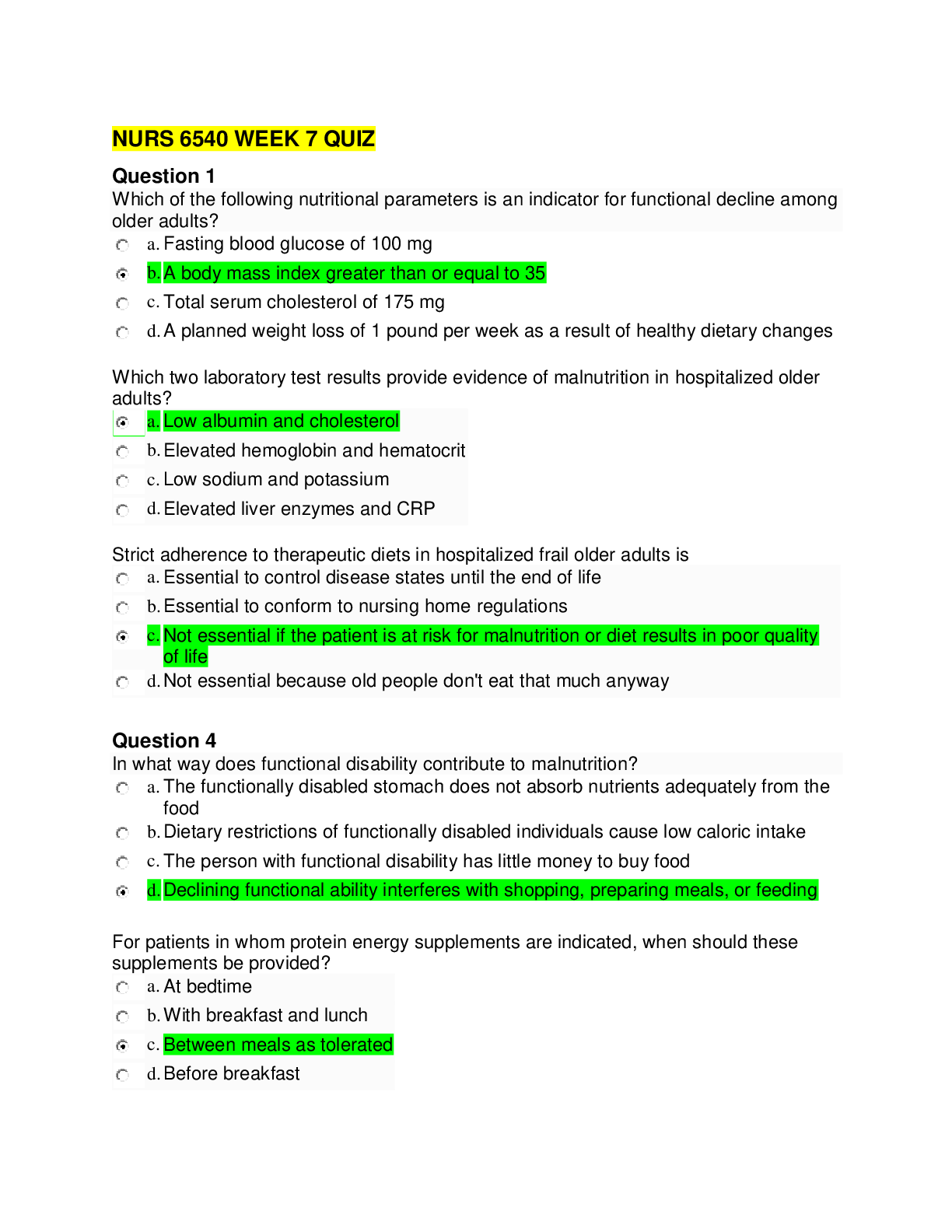
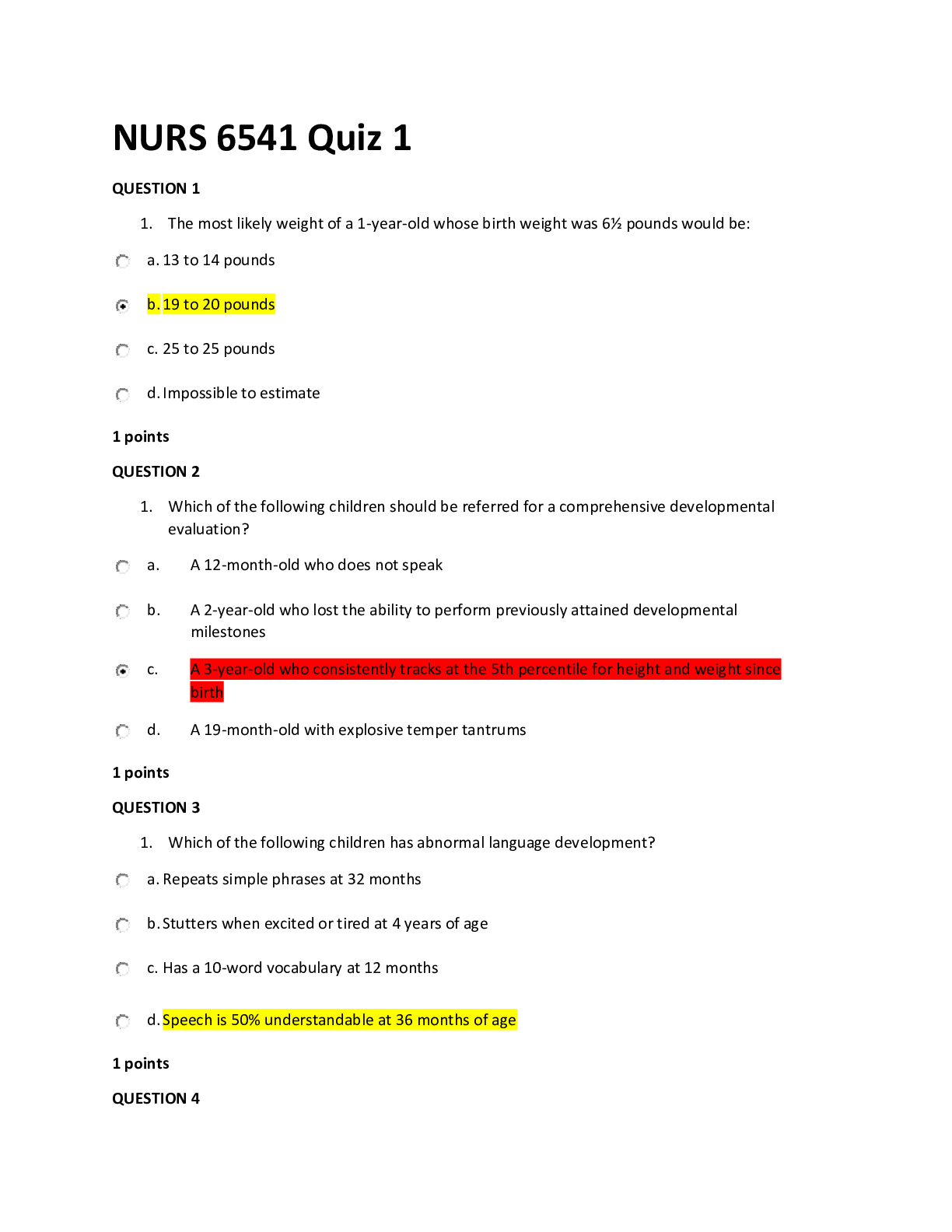
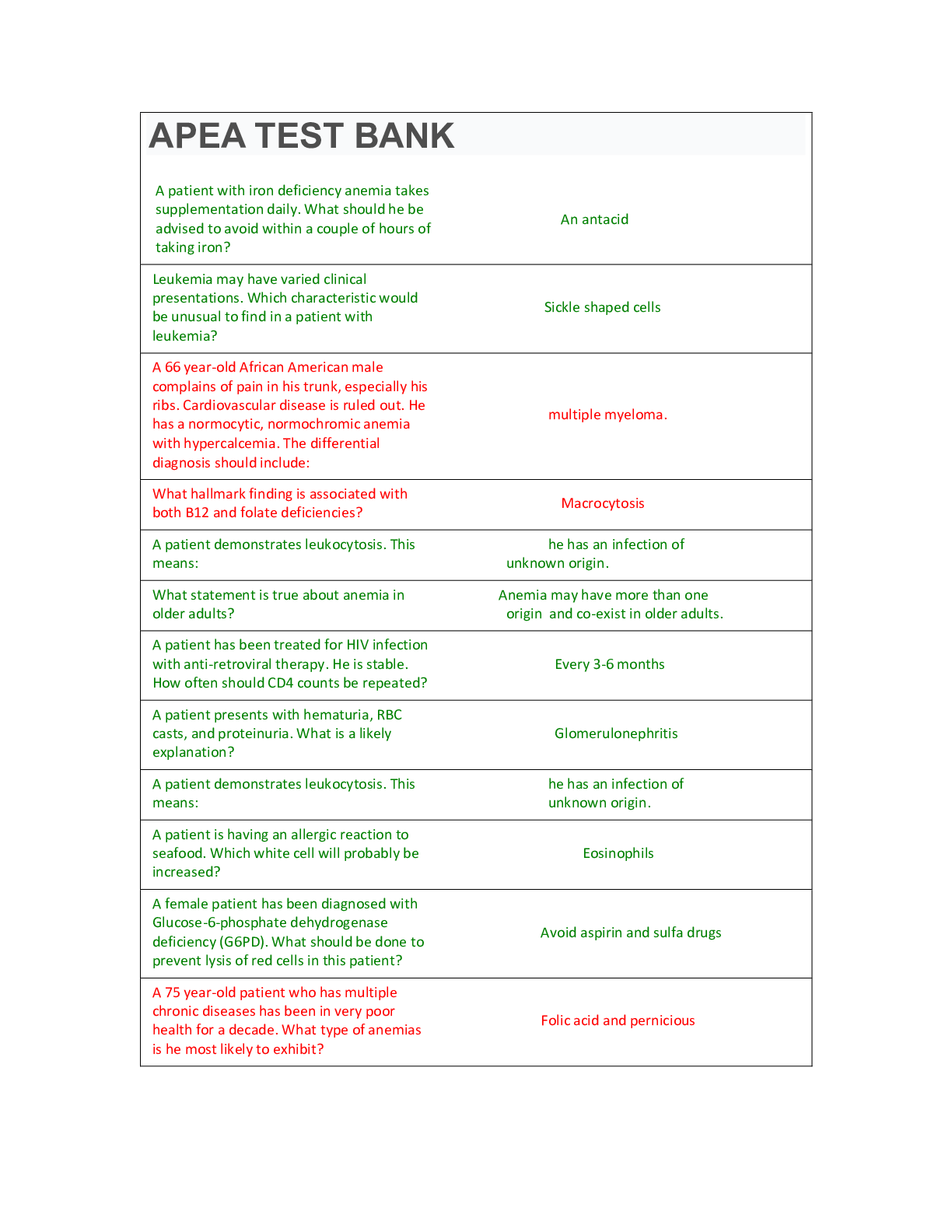
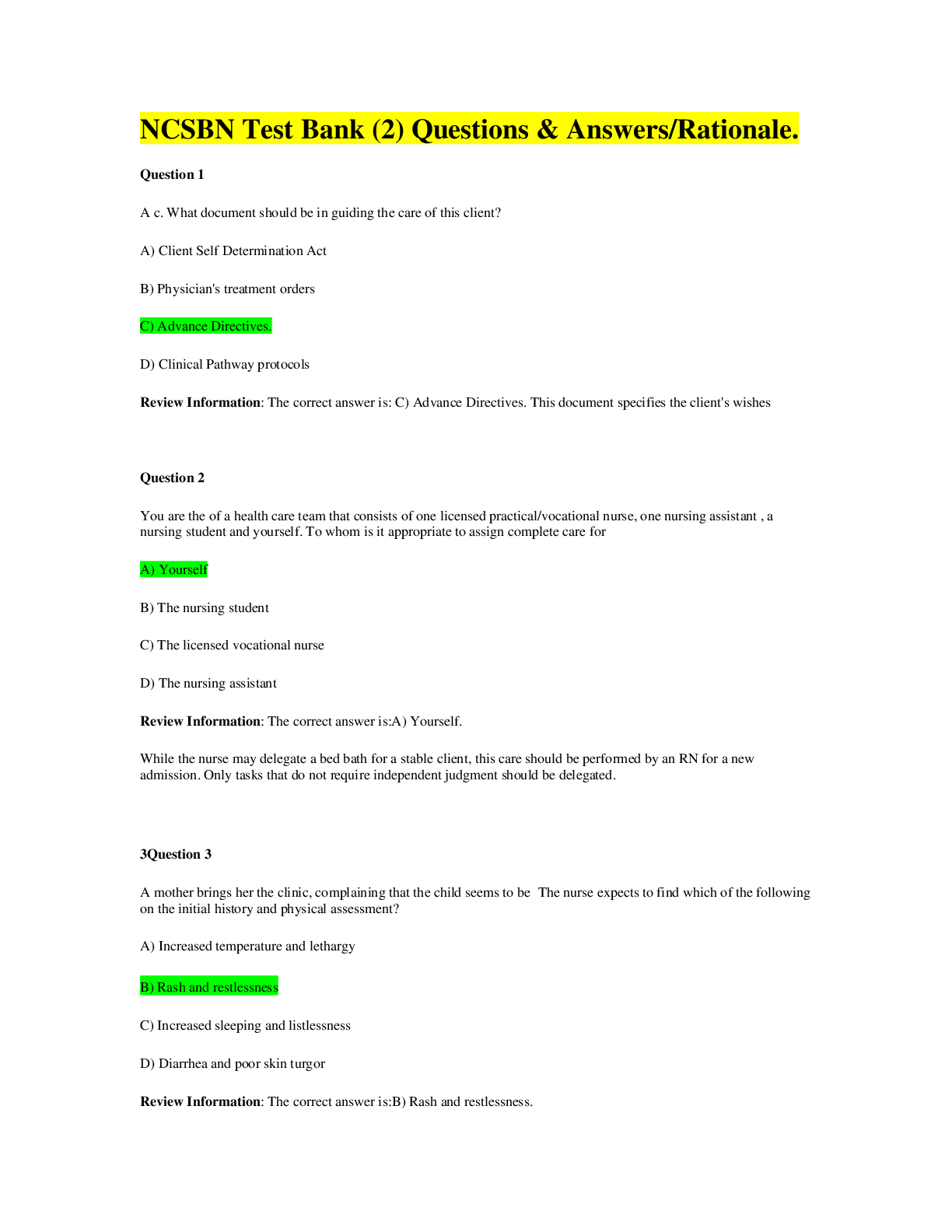
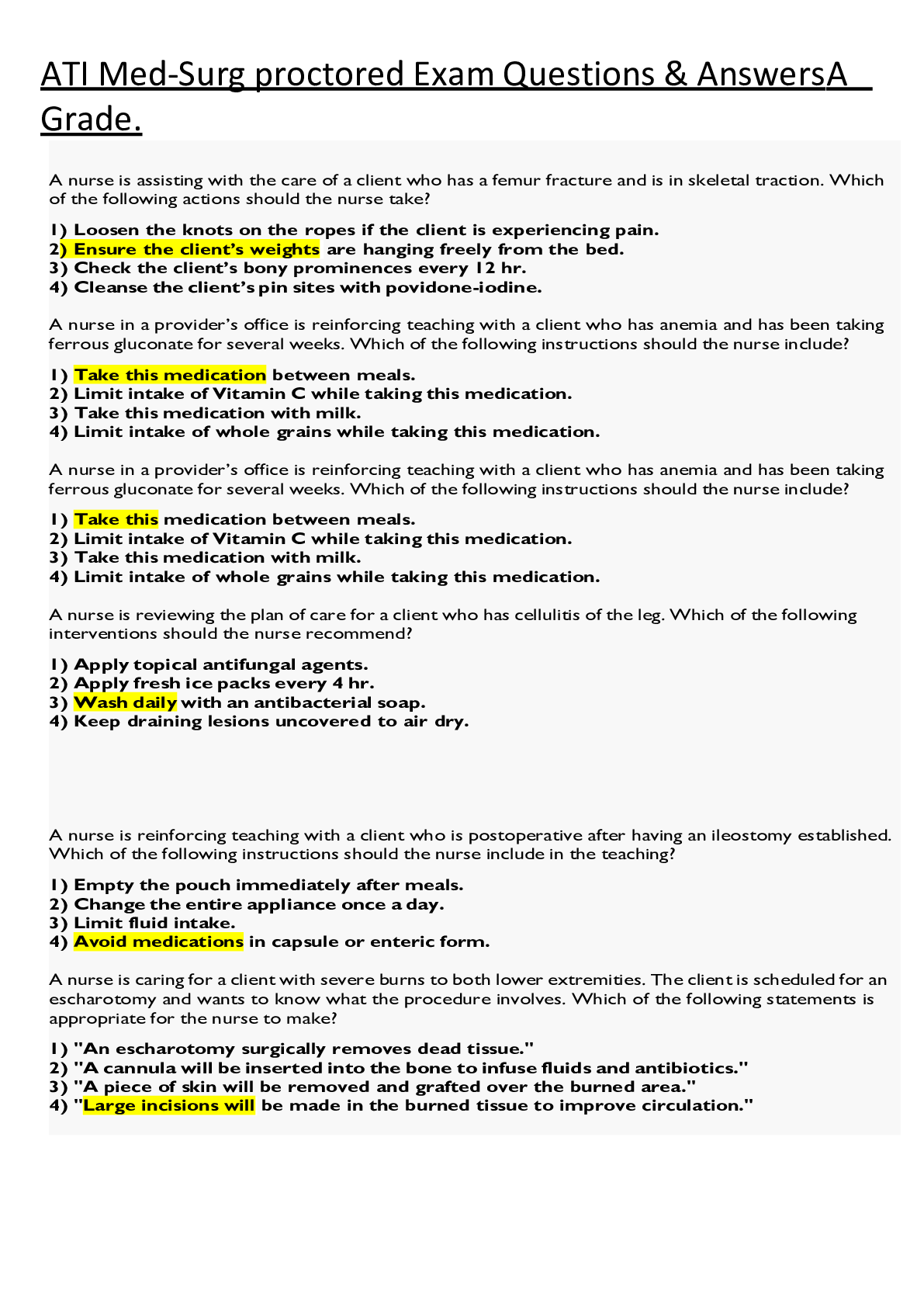




 Med Surg test Questions and Answers with Explanations, 100% Correct, Download to Score A.png)
, 100 Correct, Download to Score A.png)
, 100% Correct, Download to Score A.png)
, 100% Correct, Download to Score A.png)
, 100% Correct, Download to Score A.png)
, 100% Correct, Download to Score A.png)
, 100% Correct, Download to Score A.png)
, 100% Correct, Download to Score A.png)

